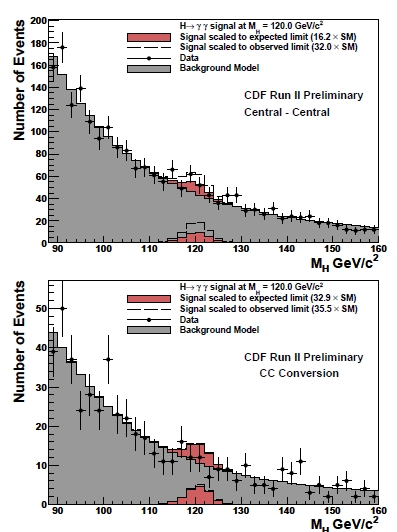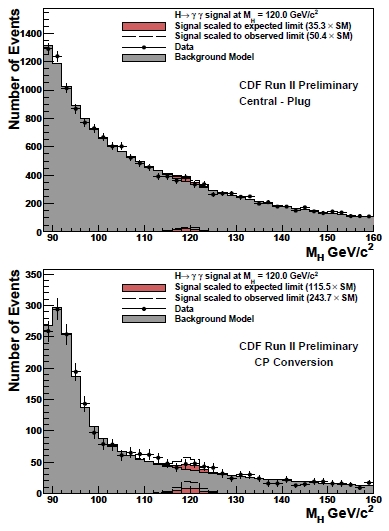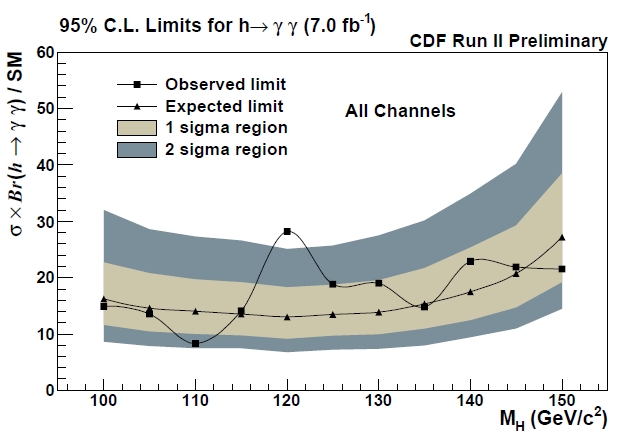(Older Note: Bet on this signal! See at the bottom of the article! Odds are two to one in your favour now!)
(Older note: Update at the bottom.)
It seems I am late on this one -an internal note by the Atlas collaboration seems to contain the discovery of a bump in the diphoton mass distribution from data collected in 2010 and 2011. They find a signal that seems consistent, in mass and resolution, with what one would expect from a Higgs decay, if the Higgs were sitting at 115 GeV, the value at which LEP II found some hint (a 1.7 standard deviation signal) before being shut down in 2001.
Since I cannot distribute information I do not possess, let me speculate on the information that has been distributed elsewhere already.
- I think the signal is false, for a few reasons:
- It is not statistically compelling; the ATLAS authors (note that this is an internal document we are discussing, so while it is ATLAS data we cannot treat the result as backed off by the collaboration) claim in their abstract a local significance of 4 standard deviations, and then proceed to estimate the overall significance by accounting for a "look elsewhere effect" in the mass spectrum they examine. This comes from the fact that the bump could have appeared anywhere in the region of mass they analyzed, so it must be a trials factor of the order of a factor 20 increase in p-value, changing 4 standard deviations into something like 3.7. But this neglects to account for the fact that there are many other places where similar bumps could have appeared and made it to the headlines but did not. I estimate the derating factor due to this "multiple search" by at least a factor of 1000 more with respect to what they claim, so their p-value is at least 1000-fold underestimated. This puts it well below the 3-sigma level.
- the width seems what ATLAS expects to obtain for a narrow state, but this depends on how they apply their cuts, looser selections finding larger widths -a clear indication that something is not right.
- the cross section is way too large for a narrow state. The SM Higgs would have a cross section thirty times smaller.
- The large production rate fights with the Tevatron bounds, which exclude such states at cross sections not too much above the standard model (x1.5). One could argue that a particle with anomalously large coupling to photon pairs could elude those limits, which for the specific gamma-gamma final state are instead 20 times larger, and thus would allow the ATLAS signal... barely. But then, let us look at the CDF and DZERO results... See below.
- In principle, the larger LHC energy could allow the "turning on" of the new process by one or two mechanisms. One is if this new particle is produced together with some other body, which is massive enough to make the production at the Tevatron disfavoured. But the ATLAS Higgs bid is for isolated diphotons with little else in the event, so this interpretation is at least on shaky ground. The other method might be if the new particle were produced by some diffractive mechanism, which would require a very special kinematic range, accessible at the LHC but not at the Tevatron. I find it rather weird too.
- I think this will never make the light of a ATLAS public document: in fact, new data is pouring in very quickly, and CMS will not sit and wait either. So I think that the signal will disappear soon in ATLAS, and that CMS will internally show their competitors that they do not see anything similar...
CDF
First of all, CDF. CDF published recently a search for H->gamma gamma, where they analyzed 7 inverse femtobarns of collisions (that's seven thousand inverse picobarns, or over 110 times the data analyzed by the ATLAS experimenters).
CDF looked for diphotons in four different combinations: central-central pairs, central-forward pairs, and CC and CP pairs where one photon is reconstructed by its conversion into an electron-positron pair. This happens when the photon crosses the strong electromagnetic field of a heavy nucleus in the detector: the CDF inner tracker contains silicon that can do this trick, but never mind -the electron and positron arising from the conversion can be reconstructed just as well as the photon. The four mass distributions that CDF finds are shown below.


As you can see, if anything CDF sees some hint of a signal above backgrounds at 120 GeV, not 115; the "signal" is however totally insignificant: the red thing they add to these plots is the amount of signal they can exclude at 120 GeV compared to the data in each figure. Note also that the 115 GeV region is, if anything, depleted of events. There is no chance that the electromagnetic energy scale is wrong by 5%... The calibration of the CDF electromagnetic calorimeter is way more precise than that, so if you were thinking that the above figures could in some way get along well with a 115 GeV bump in ATLAS data, thing better.
In the end CDF produces a upper limit on the signal cross section, shown below. As you see, the limit is above expectations (from data in hand and analysis technology) at 120 GeV, but it is in line with predictions at 115, where a signal 14 times larger than the SM is excluded.
 Maybe a couple of words should be spent on this plot: the horizontal axis shows the unknown Higgs mass; the vertical one the ratio between production ratio and SM prediction. A limit going below 1.0 on the y axis would exclude the corresponding Higgs mass on the x axis. Here we are not excluding anything because the curve stays between 10 and 30 times the predicted SM rate. The band is just showing the range of possible results that the experiment was expecting to find before actually looking at the data.
Maybe a couple of words should be spent on this plot: the horizontal axis shows the unknown Higgs mass; the vertical one the ratio between production ratio and SM prediction. A limit going below 1.0 on the y axis would exclude the corresponding Higgs mass on the x axis. Here we are not excluding anything because the curve stays between 10 and 30 times the predicted SM rate. The band is just showing the range of possible results that the experiment was expecting to find before actually looking at the data.DZERO
DZERO also searched for diphoton resonances, and I discussed the matter with many details in a recent post. They recently cast the search also into one for "fermiophobic" higgs bosons, but the method and results are directly translated into ones for the plain Higgs to gamma gamma. But let us consider the standard search instead, detailed here.
The mass distribution of diphoton pairs in 8.2 inverse femtobarns of their Run II data is shown above, together with background predictions (coloured histograms) and a 50 times larger than usual Higgs boson sitting at 115 GeV. No signal is apparent in the data, and they use this to set limits, which are shown below. Note that at 115 GeV DZERO excludes a SM Higgs with rate 20 times larger than the SM prediction. The DZERO data seems to have fluctuated 1.5 standard deviations up in that region.

In conclusions, we can say the following:
- CDF and DZERO together exclude a SM Higgs with production rates 1.5 times the prediction and above; this includes all possible decay modes studied.
- If considering only the diphoton decay mode, bounds are looser: CDF excludes a rate of 14 times the SM prediction and above; DZERO excludes rates of 20 times the SM prediction and above.
- CDF sees no excess at all at 115 GeV; DZERO sees some upward fluke, at the level of 1.5 standard deviations.
- Both experiments would have seen with certainty a signal with a rate of 30 times the SM, as an anomalous enhancement at the level of three standard deviations or so.
Other Resources on this topic
Finally, since I think this topic will remain hot for a while, I will place here links to other sites which discuss the matter. For the time being we have the usual suspects:
- Peter Woit
- Resonaances
- Lubos Motl
- Francis The Mule (in Spanish)
- Bad Physics
- Philip Gibbs
- Gordon Watts (on scientific integrity)
- Physikblog (in German)
- Wired
- Fox News
- Linuxfr (in French)
- Daily Galaxy
- New Scientist
- itwire
- livescience
- Repubblica (in Italian)
Update: a reader of this blog, PtrSlv2, pointed out in the blog of Resonaances that the authors of the ATLAS study are actually physicists from Wisconsin, and include Prof. Wu, who was among those less happy of the decommissioning of LEP II at the time when they were claiming a possible Higgs signal at 115 GeV. So maybe these guys have been looking for some comfirmation of the 115 GeV Higgs all along... Check out this article for details.
Update: I cannot avoid commenting further here upon realizing that some of you do believe that the signal is genuine (see Lubos comment for instance). I have a different opinion, but I realize that anybody is entitled to his or her opinion -especially on such a fast-moving subject. In any case my comment is the following: in 2009 I was invited to the World Conference of Science Journalists, where discussing "Blogs, Big Physics, and Breaking News" in the glorious Westminster Hall (which seats over 2000, although my audience was admittedly much smaller) I made a very precise prediction on the Higgs boson, namely that the first we would hear about it would be in a blog comment. It seems that this is a perfect dry run for the prediction, validating it fully. Indeed, this being the Higgs or not, my prediction was valid ;-)
(Addendum: here are two quotes from the transcript of my talk:
"So who will have the news about the higgs boson, which is this handsome particle which was hypothesized more than 40 years ago, which fixes everything -well, not everything but many things about the subatomic world ? I think it will be announced many times. This has already started happening. It started in 2001 at CERN, and then it is going on..."And later I conclude the talk with this:
"And the Higgs boson will be announced several times before it is actually there, and it might come out from anonymous comments."Yep - right on the money. Hmm I should stop saying I was right, it's becoming a habit. It does not make one too popular!)
In any case, let me throw this in the water for Lubos or other believers here: I bet $1000 with whomever has a name and a reputation in particle physics (this is a necessary specification, because I need to be sure that the person taking the bet will honor it) that the signal is not due to Higgs boson decays. Details to be fixed. So be the first and take the bet!! If these are four standard deviations, it's a winning bet, isn't it ? The 4-sigmas quoted by the paper mean that the probability that this is NOT a new particle is ridiculously small, right ? (wink, wink).
I realize the above highlighted text might be taken to mean that I believe this is a signal, but of something else. No, I am willing to bet that this is NO NEW PARTICLE. Clear enough ?
Update on the bet: Okay, since a reader pointed out in the comments thread that the note starts with a quite startling statement, I changed my evaluation on the whole story. I am now twice as convinced that the bump is a fake, and that the four authors look too enthusiastic for me to appear as rigorous particle physicists. I will offer $1000 if a new resonance is confirmed at 115 GeV in the diphoton final state with, say, 10 times more data than analyzed in the paper we are discussing (this makes it about 700/pb, which will be collected in a few more months). If, on the other hand, no new such particle is confirmed by the time the experiments collect 10 times more data, I will receive $500.
Any takers ? Use the comments thread and remember, you must use your real name and be prepared to pay if you lose.




Comments